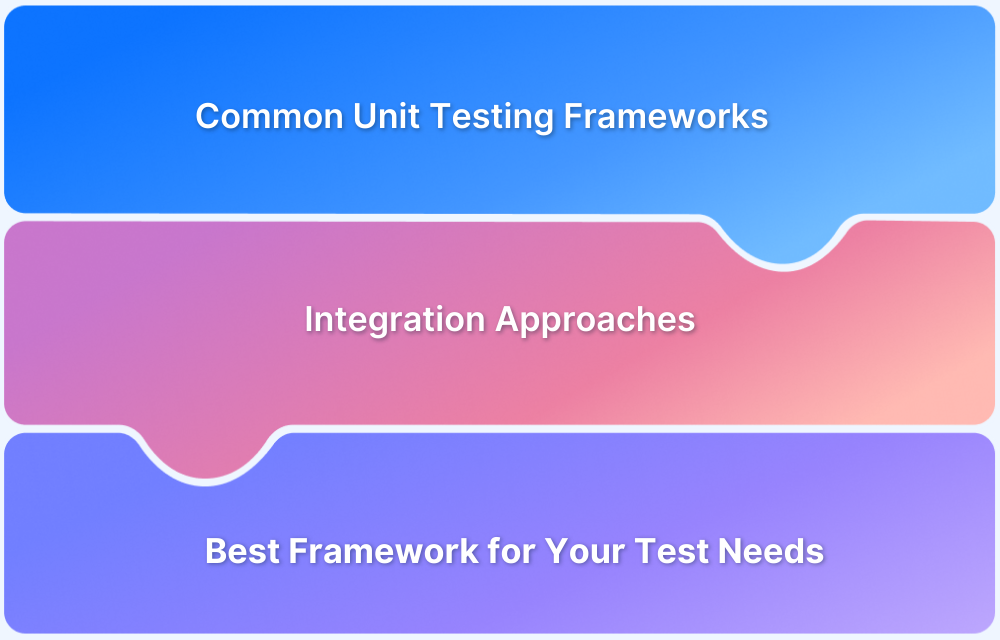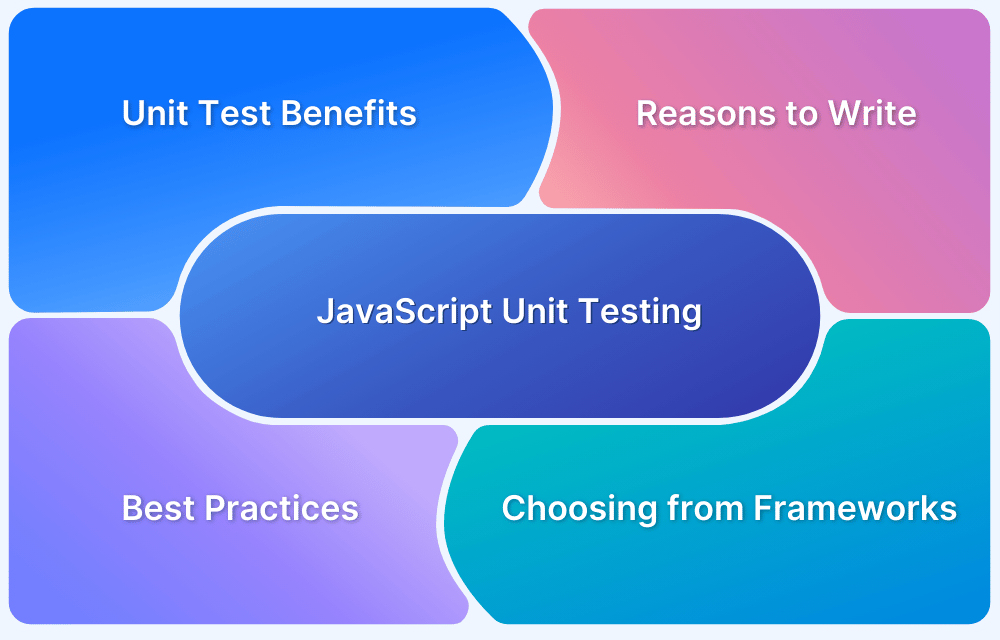Unit testing is very crucial in the overall testing framework by verifying that individual components of a codebase function correctly. It sits at the base of the testing pyramid, where it is the fastest and least expensive form of testing.
Overview
Unit testing is a technique to test individual components or modules of a program in isolation, ensuring they function correctly and catching bugs early in development.
Types of Unit Testing: Manual & Automated Unit Testing
Unit Testing Strategies
- Test-Driven Development
- Behaviour-Driven Development (BDD)
- Mocking and Stubbing
Unit Testing Process
Step 1: Analyze your code
Step 2: Write Test Cases
Step 3: Set Up the Test Environment
Step 4: Execute the Tests
Step 5: Run Tests Again
Step 6: Review Results
This guide provides an extensive description of unit testing, its types, strategies, processes, challenges, and more.
What is Unit Testing?
Unit testing is a software testing method in which individual components or modules of an application are tested in isolation to verify their correctness. These components are often the smallest testable parts of an application, including functions, methods, or classes.
The main purpose of unit testing is to verify that each unit of the codebase is working correctly for different input conditions. This approach enables developers to catch and fix bugs as soon as the bug can arise to obtain cleaner, more reliable code.
Developers often create unit tests and execute them as part of the development cycle. Well done unit testing can save debugging time while improving the maintainability of the codes.
Why perform Unit Testing?
Here is why you must perform unit testing of applications:
- Ensures individual pieces of code work as intended.
- Helps catch bugs early, before they become bigger issues.
- Simplifies fixing problems in the development phase.
- Improves code reliability from the start of the project.
- Reduces the risk of defects in later testing stages.
What are Unit Tests?
Unit tests are real test cases drafted to validate the proper behavior of a given code unit. The test generally comprises one or more input values passed on to a function or method and verifying whether the output is correct.
A simple pattern that most unit tests follow is called AAA:
- Arrange: Setup test environment, with input values
- Act: Call the unit of code being tested.
- Assert: Compare actual result with expected result to determine whether test will be successful or not.
These tests are also done in isolation, so that one can assert the specific code unit under test works as expected even if there is a complete lack of external dependencies or even the database, for instance. Mocking and stubbing can also be used in unit testing; however it could represent an external system as to focus their test solely on the logic within the unit itself.
Prerequisites for Unit Testing
Before diving into unit testing, there are a few important things you need to have in place:
- Clear Requirements: Make sure that the functionality of each unit is defined well. It makes it easier to check if the output matches expectations.
- Modular Code: Organize your code into small, manageable units or functions. This makes it easier to write tests and ensures they are more effective.
- Testing Frameworks: Select a unit testing framework that fits your development environment, like JUnit, Mocha, or Jest.
- Mocking Tools: For any part of your code that interacts with external systems, use mock objects to simulate those dependencies during testing.
- Automation Setup: Have your tools and scripts ready to automate tests, saving time and improving efficiency in the long run.
Read More: Top Unit Testing Frameworks
Types of Unit Testing
Unit testing can be done in two main ways: manually or automatically.
Manual Unit Testing
Manual unit testing involves executing test cases manually without the help of automation tools. In this approach, testers or developers verify the functionality of individual units by providing inputs, observing outputs, and comparing them with expected results. It is typically used in situations where:
- The unit or component is simple and does not require repeated testing.
- Automation is not feasible due to resource or time constraints.
While manual unit testing can be useful for small-scale or exploratory testing, it is prone to human errors and can become tedious and inefficient for large or complex projects.
Read More: Manual Testing for Beginners
Automated Unit Testing
Automated unit testing involves writing and running test cases using specialized frameworks and tools like JUnit, pytest, NUnit, or TestNG. This method automates the testing process, making it faster and more reliable. Benefits include:
- Consistency: Automated tests reduce the risk of human errors and ensure repeatability across multiple test runs.
- Efficiency: Saves time, especially for regression testing or projects requiring frequent code changes.
- Scalability: Handles many test cases, including edge cases and complex scenarios, easily.
Automated unit testing is essential for modern software development workflows, particularly when integrated with CI/CD pipelines to maintain high-quality code during rapid development cycles. It is well-suited for repetitive testing tasks and large, dynamic projects.
Read More: Automated Testing: Benefits, Strategy, Tools
Unit Testing Strategies
To optimize its benefits, an effective strategy must be followed in implementing unit testing.
- Test-Driven Development. Writing unit test before developing the real code is the process of Test-Driven Development. TDD assures that the high quality code will be written and it will be well-structured with testing involved from the very beginning.
- Behaviour-Driven Development (BDD): BDD 165 focuses on the test of behavior of a system instead of its implementation. Unit tests in BDD are written in natural language and hence more understandable to the non-technical stakeholders.
- Mocking and Stubbing: This approach replaces all external dependencies in such a way that the code unit being tested is not influenced by any other part of the system.
Unit Testing Process
The process of unit testing generally involves the following steps:
Step 1: Analyze your code: Identify what you have to test, understand its working, and develop a plan test cases.
Step 2: Write Test Cases: Create test cases for all scenario the unit may encounter, including edge cases and error conditions.
Step 3: Set Up the Test Environment: Choose your preferred unit testing framework and set up the environment needed to run your tests smoothly.
Step 4: Execute the tests: Run the tests and verify if the unit behaves as expected under all scenarios.If it fails, debug your code and remove any bugs there to run the test again
Step 5: Run tests: Ensure that the unit remains correct with modifications.
Step 6: Review Results: Analyze the test outcomes, fix issues if present, and then re-run the tests to ensure everything works.
What is Application Unit Testing?
Application unit testing refers to applying the principles of unit testing towards individual components of a larger software application.
The process is assured that each part of an application – whether a method, class, or function – does what is supposed to do before it gets to be part of the system.
Application unit testing is important in complex applications because even minor bugs introduced in one unit may cause failure of the entire system. Early validation of units will help avoid lengthy and costly fixes at the later stages when bugs would be tougher to trace and rectify.
Most application unit testing is automated in continuous integration pipelines so that any change to code immediately triggers automated tests before the changes are merged into the main code.
Read More to Learn:
Unit Testing Techniques
Unit testing is performed using three main techniques:
1. Structural Testing (White Box Testing)
Structural testing examines the internal structure of the program. It’s often called White Box or Glass Box testing.
This technique requires a deep understanding of the code, so developers typically handle it. The goal is to verify how the system performs tasks internally, focusing on how it works rather than just what it does.
2. Functional Testing
Functional testing verifies that each feature of your application works as desired. You must provide sample inputs and check if the actual output matches with user expectations.
Also Read: What is Automated Functional Testing
3. Error-Based Testing
Error-based testing is driven by the developer who wrote the code, as they understand it best. Common error-based methods include:
- Historical Test Data: Prioritizes tests using data from previous test cases to decide which cases are most critical.
- Mutation Testing: Involves deliberately modifying parts of the code to see if the tests can catch the errors.
- Fault Seeding: Introduces known problems into the code. Testing continues until all the planted errors are found and fixed.
Unit Testing vs Other Testing Types
Here’s a comparison of unit testing with other types of testing to help you understand their key differences and where each one fits in the development process:
| Comparison | Unit Testing | Integration Testing | Regression Testing | Functional Testing |
|---|---|---|---|---|
| Focus | Isolates individual units or components. | Tests interactions between different units or modules. | Ensures new code doesn’t affect existing functionality. | Verifies the system works according to functional requirements. |
| Scope | Small, specific sections of code. | Multiple integrated components. | Entire codebase, focusing on previously working parts. | End-to-end system behavior. |
| Objective | Validate correctness of specific units. | Ensure units work well together. | Detect new bugs in existing features. | Check if the application meets user requirements. |
| Example | Testing a single function or method. | Testing the interaction between a database and a web service. | Running tests after updates to check for regressions. | Testing if a login page works as expected. |
Mocking and Stubbing in Unit Testing
Mocking and stubbing are techniques used in unit testing to isolate the code being tested by replacing its dependencies with controlled, simulated versions. These techniques ensure that the tests focus solely on the unit under test, without interference from external systems, databases, APIs, or other components.
Mocking involves creating a simulated version of an object or component that mimics the behavior of a real dependency. Mocks are typically used to verify interactions, such as whether certain methods were called or specific data was passed.
Example Use Case:
- Verifying that a sendEmail() method is called with the correct parameters in a notification service.
Stubbing involves providing pre-determined responses or behavior for specific calls to a dependency. Stubs are typically simpler than mocks and focus on providing the necessary inputs to test the functionality of the unit.
Example Use Case:
- Returning a fixed response from a database query or an API call to test how the system processes the data.
When to Use Mocking and Stubbing?
Mocking: Use when you need to ensure the tested unit interacts with its dependencies correctly, such as verifying API calls, method invocations, or data passed.
Stubbing: Use when you need to simulate dependency behavior to provide controlled test inputs, such as returning predefined values from a method.
Best Practices for Unit Testing
To make your unit testing process more effective and reliable, it’s important to follow a set of best practices that ensure consistency and accuracy in your tests.
- Write Tests During Development: Make sure to write your unit tests while you’re developing, not after. This way, you catch bugs early and make sure your code is clean and testable from the start. It also makes your testing process more efficient in the long run.
- Avoid Logic in Tests: Keep your tests simple by avoiding logical conditions and manual string concatenation. Focus on checking the expected outcome instead of how the code works internally. If you find it necessary to add logic, break it into smaller, more simpler tests to keep things clear and easy to follow.
- Ensure Test Independence: Always make sure your tests are independent of one another. Each test should run on its own, with its own setup and teardown. This prevents issues when tests run in different orders and makes debugging much easier.
Read More: 7 Core Best Practices in Unit Testing
Top Tools for Unit Testing
1. JUnit
JUnit is a unit testing framework for Java applications, supporting test-driven development and efficient test case management.
Key Features:
- Supports annotations and assertions for simple test cases.
- Offers parameterized tests for multiple inputs.
Integrates with popular Java IDEs for seamless testing.
Pros:
- Lightweight and widely used in Java environments.
- Easy to integrate into Java development workflows.
Cons:
- Limited support for advanced mocking compared to other frameworks like Mockito.
- More complex test setups might require additional dependencies or configurations.
- Asynchronous testing support is limited in comparison to some newer frameworks.
Read More: How to write JUnit Test Cases
2. NUnit
NUnit is a flexible unit testing framework for .NET languages, providing parallel execution and powerful assertions.
Key Features:
- Supports multiple assertions and test runners.
- Runs tests in parallel, enhancing performance.
- Works seamlessly with .NET platforms.
Pros:
- Cross-platform compatibility.
- Great for complex .NET testing needs.
Cons:
- Has a steeper learning curve for new users due to the wide range of features.
- Requires additional setup for non .NET environments.
- May need extra configuration for parallel execution in larger projects.
3. Mocha
Mocha is a feature-rich JavaScript testing framework designed for Node.js applications.
Key Features:
- Asynchronous testing capabilities.
- It supports multiple reporters and customizable outputs.
- Makes easy integration with other JavaScript testing libraries.
Pros:
- Highly flexible for Node.js applications.
- Asynchronous testing makes it ideal for real-time applications.
Cons:
- Lacks built-in mocking and assertion libraries (requires additional tools like Chai or Sinon).
- Not as fast as Jest for large-scale test suites.
- Asynchronous testing can become complex with nested callbacks or promises.
4. Jest
Jest is a popular JavaScript testing framework, especially for React applications, designed for simplicity and speed.
Key Features:
- Snapshot testing and mocking capabilities.
- Offers built-in assertions and code coverage tools.
- Runs tests in parallel for better performance.
Pros:
- Fast, easy setup.
- Ideal for React and front-end JavaScript frameworks.
Cons:
- Performance can degrade with very large test suites.
- Limited support for non-JavaScript environments.
- Might require configuration tweaks for certain projects with complex testing needs.
Read More: How to Configure Jest
5. PyTest
PyTest is a powerful and flexible Python testing framework, suited for both simple and complex test scenarios.
Key Features:
- Supports fixtures and parameterized testing.
- Highly extensible with plugins.
- Simple, readable syntax for easy test writing.
Pros:
- Scalable and versatile.
- Extensible with a large range of plugins.
Cons:
- Plugins can introduce complexity, especially when debugging.
- Not as beginner-friendly as simpler frameworks like unittest.
- Fixtures can sometimes be difficult to manage in complex test suites.
Read More: Pytest vs Unittest: A Comparison
6. xUnit.net
xUnit.net is a modern testing framework for .NET, offering extensibility and support for parallel execution.
Key Features:
- Supports parallel test execution for faster results.
- Extensible with custom libraries.
- Provides “theory” testing for multiple inputs.
Pros:
- Modern and efficient for .NET development.
- Easily extensible for complex tests.
Cons:
- Less widely used than NUnit, which means smaller community support.
- Limited built-in features for mocking and dependency injection.
- Migrating from other .NET frameworks might require significant refactoring.
Read More: NUnit vs XUnit vs MSTest: Core Differences
7. TestNG
TestNG is a testing framework for Java offering advanced features for complex testing scenarios.
Key Features:
- Supports parallel execution and annotations.
- Allows data-driven and parameterized tests.
- Integration with tools like Jenkins and CI/CD pipelines.
Pros:
- Great for large-scale testing.
- Supports detailed configurations.
Cons:
- More complex configuration compared to JUnit for simple testing tasks.
- Can be overkill for small or straightforward projects.
- Slower for smaller test suites due to its complexity and advanced features.
Read More: How to Automate TestNg in Selenium
8. RSpec
RSpec is a behavior-driven development (BDD) framework for Ruby, known for its easy-to-read syntax.
Key Features:
- Provides a BDD-style test writing for clarity.
- Extensive matchers for verifying code behavior.
- It has an easily readable and expressive syntax.
Pros:
- Readable syntax, ideal for Ruby developers.
- Great for behavior-driven testing.
Cons:
- Slower execution compared to simpler Ruby testing frameworks.
- Might require more setup for complex integration tests.
- Behavior-driven development (BDD) style may not be suitable for all projects.
Read More: How to achieve Advanced BDD Automation
9. Vitest
Vitest is a unit testing framework for modern JavaScript and TypeScript applications, designed with Vite in mind. It’s particularly useful for projects leveraging Vite’s fast build process and hot module replacement.
Key Features:
- Integrated with Vite, which enables ultra-fast test execution.
- Supports TypeScript and JavaScript natively.
- Provides built-in mocking and snapshot testing.
- Offers instant feedback and real-time test updates with Vite’s hot module replacement (HMR).
Pros:
- It is extremely fast, especially for Vite-based projects.
- It has built-in support for TypeScript and mocking, reducing the need for additional libraries.
- Great developer experience with real-time feedback during test runs.
Cons:
- Primarily optimized for Vite projects, so it is less useful for applications not using Vite.
- Limited ecosystem compared to more mature tools like Jest.
Advantages of Unit Testing
Here are some of the advantages of unit testing:
- Early Bug Tracking: Identifies and resolves issues at an early stage, reducing debugging time in later phases.
- Improved Code Quality: Ensures each unit functions correctly, leading to more reliable and maintainable code.
- Facilitates Refactoring: Simplifies code changes by providing a safety net to verify correctness after modifications.
- Supports Continuous Integration: Integrates seamlessly into CI/CD pipelines, ensuring code quality with every build.
- Documentation: Acts as living documentation for understanding the functionality of individual components.
Challenges in Unit Testing
Here are some of the challenges of unit testing:
- Dependency Management: Testing units in isolation can be difficult when they rely on external systems or modules.
- Mocking Complexity: Creating accurate mocks or stubs for dependencies can be time-consuming and error-prone.
- Flaky Tests: Tests may produce inconsistent results due to environmental issues or poor test design.
- Time Investment: Writing comprehensive unit tests requires significant time and effort, especially for legacy code.
- Limited Scope: Unit tests focus on individual components, potentially missing integration issues or broader system behavior.
How to perform Unit Testing with Selenium
Unit testing with Selenium is about testing the specific components of your web application to make sure that they function as expected. Also, Selenium itself is primarily used for browser automation, but it can also be integrated with unit testing frameworks to validate specific features in isolation.
Start by selecting a unit testing framework for your preferred programming language. For example:
- Java: JUnit or TestNG
- Python: unittest or PyTest
- JavaScript: Mocha or Jasmine
- Ruby: RSpec
Here are some additional resources to help you conduct unit testing using Selenium
These frameworks integrate smoothly with Selenium, enabling you to automate browser interactions while simultaneously testing individual units of your code. Write your unit tests within the framework, using Selenium WebDriver to interact with web elements, perform actions, and validate results.
Conclusion
Unit testing is significant in software development because it ensures that individual components of a system work as intended.
Once your unit tests are ready, you can scale your testing with a tool like BrowserStack Automate. BrowserStack offers a Cloud Selenium Grid that allows you to run your automated tests across over 3,500 real devices and browsers.
With BrowserStack, you can effortlessly conduct cross-browser testing after conducting unit testing. It helps to check if your entire web application functions accurately across different platforms. Moreover, BrowserStack supports parallel test execution, so you can save time and speed up your testing process.









